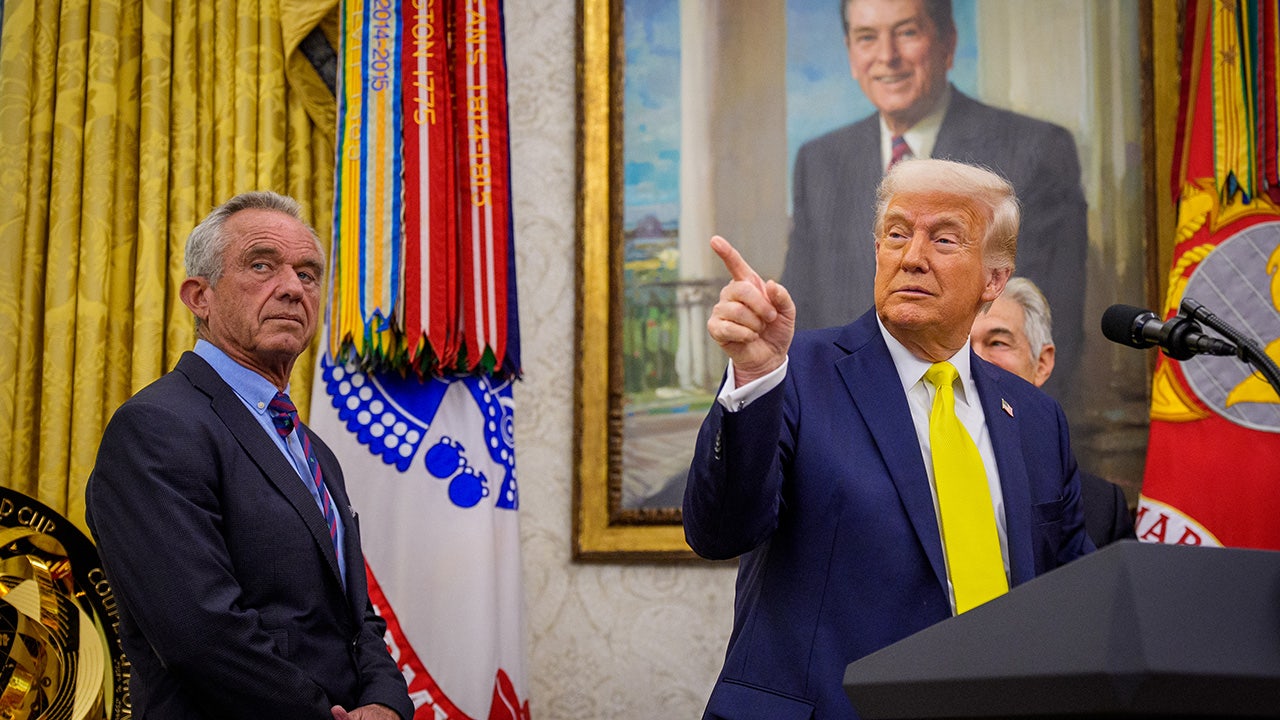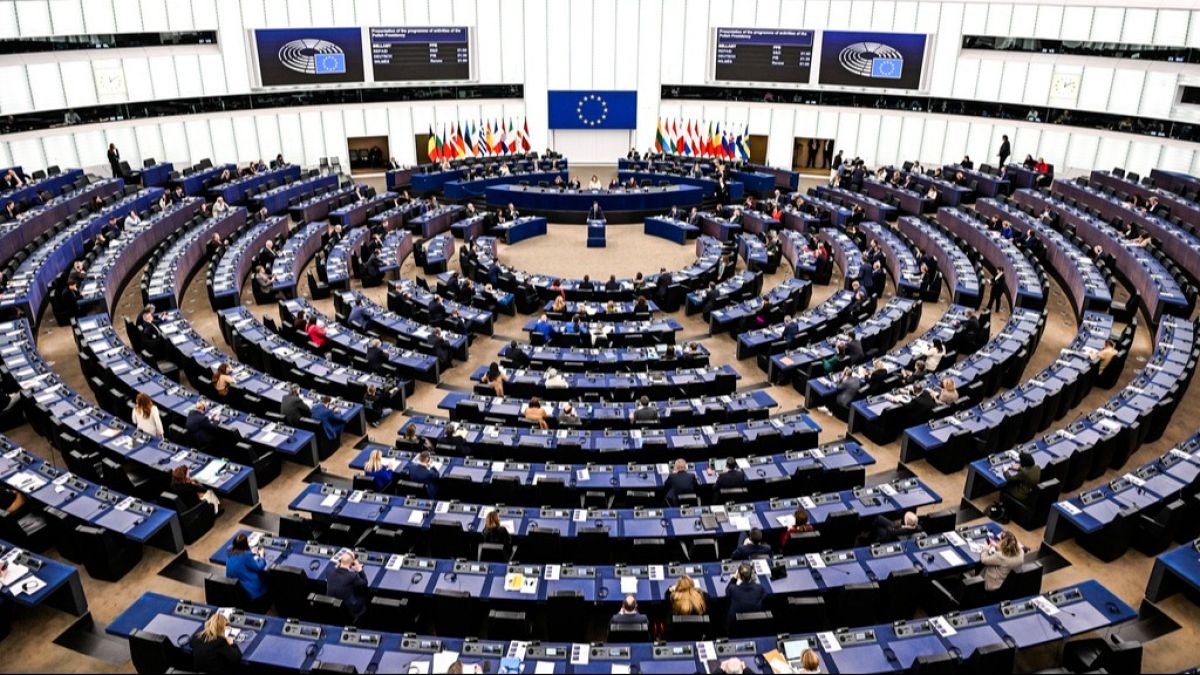Business
The Federal Work Force Grew Briskly Under Biden. It’s Still Historically Low.

When it comes to the federal payroll, two seemingly contradictory things are true.
One, the Biden administration went on a hiring spree that expanded the government work force at the fastest pace since the 1980s. And two, it remains near a record low as a share of overall employment.
In the four years separating President-elect Donald J. Trump’s two terms, the federal civilian head count has risen by about 4.4 percent, according to the Labor Department, to just over three million, including the Postal Service.
But that’s a much slower pace than private payrolls have grown over the past four years. And it leaves the federal government at 1.9 percent of total employment, down from more than 3 percent in the 1980s.
The incoming administration promises to erase whole sections of the federal bureaucracy: Vivek Ramaswamy, co-chair of what Mr. Trump is calling the Department of Government Efficiency, has said 75 percent of the work force could go, in pursuit of $2 trillion in cuts. But it will be a challenge to find cuts without depleting services.
“When we’re looking at the numbers of the federal work force, it’s still about the same size as it was in the 1960s,” said Max Stier, president of the Partnership for Public Service, a think tank. “The narrative out there is the federal government work force is growing topsy-turvy, and the reality is that it’s actually shrinking.”
Staffing expanded during Mr. Trump’s first term as well, by about 2.9 percent. But some agencies contracted significantly, and had bounced back as of March 2024, the latest data published by the Office of Personnel Management show.
The State Department, which had shrunk through attrition and a hiring freeze imposed by former Secretary of State Rex Tillerson, gained nearly 20 percent from 2020 to early 2024, or about 2,300 workers, not including the Foreign Service. (Some of the gain reflected passport processors, whose numbers had fallen when few people traveled overseas during the pandemic.) The U.S. Agency for International Development, which administers public health and humanitarian grants overseas, grew by 23 percent, to 4,675. U.S. Citizenship and Immigration Services, part of the Department of Homeland Security, rebounded to 22,500, the highest level in its history, after a hiring freeze and funding shortfalls.
Other agencies with rising head counts were driven by some of President Biden’s legislative initiatives — especially the Bipartisan Infrastructure Law and the Inflation Reduction Act. Recruiters streamlined hiring procedures to bring on more than 9,000 people, distributed across the agencies handling parts of the laws.
The Treasury Department also expanded as the Internal Revenue Service received an $80 billion infusion — later cut to $40 billion — that allowed it to top 100,000 employees, the highest level since 1997.
But the biggest increase came at the largest agency: the Department of Veterans Affairs, which stands at more than 486,000 employees, up nearly 16 percent since 2020. The growth was driven by the PACT Act, a law passed in 2022 that authorized $797 billion to cover more veterans exposed to toxic substances during their military service.
Veterans Affairs, together with civilian employees of the Pentagon and the military branches, accounts for 1.25 million federal workers. That’s 55 percent of the total, not counting intelligence agencies or the Postal Service. The active-duty military adds nearly 1.4 million, a tick down from 2020.
“You can’t get to $2 trillion in cuts and 75 percent of the federal work force if you’re not going to cut D.O.D.,” said Randy Erwin, national president of the National Federation of Federal Employees, referring to the Department of Defense. “It’s too big — it’s impossible to get to those numbers.”
Hiring at veterans’ hospitals and at field offices to support infrastructure projects has meant that all of the federal staffing growth has happened outside the Beltway. The number of federal workers in the Washington metropolitan area has been flat since 2020, and stands at about 12 percent of the total.
Some of that arises from the trend toward remote work, which allowed agencies to hire specialized talent elsewhere in the country. Although pay varies by locality, for each occupation federal workers make nearly 25 percent less than their private-sector counterparts, according to the Federal Salary Council.
“We are told by hiring managers in the District that particularly for tech occupations, they have a real hard time attracting workers,” said Terry Clower, director of the Center for Regional Analysis at George Mason University, in Northern Virginia. “It’s because a lot of folks are not really keen to move to our area, with its cost of living, for a federal wage.”
Of course, the size of the federal government is measured by more than its payroll. As policymakers have tried to keep the head count low, the number of people doing federal work as employees of federal contractors has ballooned. No one knows how many, but a Brookings Institution scholar estimated the contracted work force at five million in 2020.

Business
Darren Aronofsky joins AI Hollywood push with Google deal

Director Darren Aronofsky has pushed artistic boundaries with movies including “Requiem for a Dream” and “Mother!”
Now his production company is working with Google to explore the edge of artificial intelligence technology in filmmaking.
Google on Tuesday said it is working with several filmmakers to use new AI tools as part of a larger push to popularize the fast-moving tech. That effort includes a partnership with Aronofsky’s venture, Primordial Soup.
Google’s AI-focused subsidiary DeepMind and Aronofsky’s firm will work with three filmmakers, giving them access to the Mountain View, Calif.-based giant’s text-to-video tool Veo, which they will use to make short films. The first project, “Ancestra,” is directed by Eliza McNitt. Aronofsky is an executive producer on the film. “Ancestra,” which premieres at the Tribeca Festival next month, combines live-action filmmaking with imagery generated with AI, such as cosmic events and microscopic worlds.
“Filmmaking has always been driven by technology,” Aronofsky said in a statement that referenced film tech pioneers the Lumiere brothers and Thomas Edison. “Today is no different. Now is the moment to explore these new tools and shape them for the future of storytelling.”
The push comes as Google and other companies are making deals with Hollywood talent and production companies to use their AI tools. For example, Facebook parent company Meta is partnering with “Titanic” director James Cameron’s venture, Lightstorm Vision, to co-produce content for its virtual reality headset Meta Quest. New York-based AI startup Runway has a deal with “Hunger Games” studio Lionsgate to create a new AI model to help with behind-the-scenes processes such as storyboarding.
Many people in Hollywood have been critical of AI tools, raising concerns about the automation of jobs. Writers worry about AI models being trained on their scripts without their permission or compensation. Tech industry executives have said that they should be able to train AI models with content available online under the “fair use” doctrine, which allows for the limited reproduction of material without permission from the copyright holder.
Proponents of the technology say that it can provide more opportunities for filmmakers to test out ideas and show a variety of visuals at a lower cost.
New York-based Primordial Soup said in a press release that Google’s AI tools helped solve “practical challenges such as filming with infants and visualizing the birth of the universe” in “Ancestra.”
“With ‘Ancestra,’ I was able to visualize the unseen, transforming family archives, emotions, and science into a cinematic experience that feels both intimate and expansive,” McNitt said in a statement.
The two additional filmmakers and films participating in the Google DeepMind-Primordial Soup deal are not yet named.
Google made the announcement as part of its annual I/O developer conference in Mountain View.
During the event’s keynote address on Tuesday, Google shared updates on its AI tools for filmmakers, including Veo 3, which allows creators to type in how they want dialogue to sound and add sound effects. The company also unveiled a new AI filmmaking tool called Flow that helps users create cinematic shots and stitch together scenes into longer films and short stories.
“This opens up a whole new world of possibilities,” said Demis Hassabis, chief executive of Google DeepMind, in a news briefing on Monday. “We’re excited for how our models are helping power new tools for creativity.”
Flow is available through Google’s new $249.99 monthly subscription plan Google AI Ultra, which includes early access to Veo 3, as well as other benefits including YouTube Premium, Google’s AI models Gemini and other tools. Flow is also available with a $19.99-a-month Google AI Pro subscription.
Google is making other investments related to AI. On Tuesday, L.A.-based generative AI studio Promise announced Google AI Futures Fund as one of its new strategic investors. Through the partnership, Promise will integrate some of Google’s AI technologies into its production pipeline and workflow software and collaborate with Google’s AI teams.
Business
Commentary: Who's responsible for the aviation mess? Transportation Secretary Duffy says it's everyone but him

Picking out the worst performer among Donald Trump’s Cabinet appointees is a tough job — it’s a competitive race, after al l— but one member who deserves to be in the running by almost any measure of incompetence is Sean Duffy, the secretary of Transportation.
Duffy is a classic example of someone who knows who’s responsible for the screwups on his watch, and it’s never him.
He has spent the last weeks and months blaming the Biden administration for numerous operational failures in our air traffic system since he took over. Those include the Jan. 29 midair collision over Washington, D.C., that cost 67 air passengers their lives, as well as several near-misses on the ground.
I think we need to be a little bit more precise in downsizing a department with a mission as critical as DOT’s.
— Rep Steve Womack (R-Ark.)
Some Trump Cabinet members have more important portfolios than Duffy —Homeland Security Secretary Kristi Noem and Defense Secretary Pete Hegseth, neither of whom has displayed anything approaching basic competence at their job, come immediately to mind.
But the American public is bound to be particularly sensitive to the functioning of our transportation infrastructure. That’s especially true when it comes to the safety and reliability of air travel; every flight delay and safety-related mishap hits American travelers in the gut.
The highest-profile failure (so far) is the disaster named Newark Liberty International Airport, where flight delays can last for the better part of a day and questions about safety are rife.
Duffy, a former reality show contestant and four-term congressman, comes to the blame game with dirty hands. Let’s take a look.
First, here’s what he’s said about the condition of FAA operations and staffing.
“I think it is clear that the blame belongs with the last administration,” he said Monday during a news conference at DOT headquarters. “Pete Buttigieg and Joe Biden did nothing to fix the system that they knew was broken.” He said, “During COVID, when people weren’t flying? That was a perfect time to fix these problems.”
A couple of points are pertinent here. First, in 2019, when Duffy was a Republican member of Congress from Wisconsin, the bill to fund the Department of Transportation among other agencies came before the House. Duffy voted against it. So did 179 other members of the GOP caucus; 12 Republicans joined the Democrats to pass the measure.
Second, the pandemic year in which “people weren’t flying” was 2020. That year, the domestic passenger count plummeted to 369.4 million from 926.7 million the previous year. It was the lowest figure since 1984.
Who was president in 2020? Not Biden, but Donald Trump.
After 2020, passenger loads crept back up, reaching 666.2 million in 2021 and continuing higher to the record of 982.7 million last year. If there was an opportunity to upgrade the air traffic system at the least inconvenience to passengers, it was 2020. But nothing was done then, on Trump’s watch.
I asked the Department of Transportation last week if Duffy could reconcile these evidently misleading and inconsistent statements. I’m still waiting for a reply.
Duffy has maintained that it’s still safe to fly in and out of Newark, despite outages during which air traffic controllers’ screens went black and radios went silent — for 30 seconds on April 28 and 90 seconds on May 9. A backup system failed at the airport May 11 for 45 minutes, causing delays and cancellations for hundreds of flights.
Duffy admitted to the right-wing radio host David Webb on May 12 that he had switched his wife’s flight reservation for the next day from Newark to LaGuardia airport. He subsequently explained that he didn’t say to do so because he thought Newark was unsafe, but to spare her a long delay. In other words, he had found a solution for his family, but not for the overall traveling public, which didn’t speak well for his management of the mess at Newark.
It’s proper to note that the Federal Aviation Administration has been in an operational funk for years. Duffy can try to blame Biden, but that’s a smokescreen. During Trump’s first term, when the FAA’s problems were well known, hiring and deployment of air traffic controllers actually shrank from the level during the Obama administration according to the DOT’s inspector general, to the point where staffing “could not keep pace with attrition.”
In the first budget he submitted after taking office in 2017, Trump proposed slashing the DOT budget by 13%. The budget plan called for cutting 30,000 workers from the FAA staff.
The problems date back even further — at least to 1981, when Ronald Reagan fired 11,000 air traffic controllers at a single blow to break their union. A frenzy of hiring and training followed, but the replacement cohort has passed its retirement age. The FAA is currently about 3,000 controllers shy of its target staffing, so the people on the job are stretched to their breaking point.
It isn’t as if Trump and Duffy pulled out all the stops to fix the FAA’s chronic problems upon taking office. Some 3,000 “probationary” employees at the agency were fired during a DOGE rampage, according to a count by the Professional Aviation Safety Specialists, the union representing safety and technical workers at the FAA, and a statement by Rep. Steve Womack (R-Ark.), chair of the subcommittee overseeing the Transportation Department budget. The probationary firings and two subsequent rounds of buyouts will bring staffing at the DOT down by 12% since Trump took office.
During appearances last week before the House and Senate appropriations committees, Duffy boasted about saving taxpayers nearly $10 billion during the first 100 days of the Trump administration. That provoked Womack to riposte, “I think we need to be a little bit more precise in downsizing a department with a mission as critical as DOT’s. … The question is pretty simple: How many departures can you handle without eroding the ability to carry out a safe and effective mission?”
“We can do more with less, Mr. Chairman,” Duffy replied. When staff accept buyout offers to retire or resign, he said, “we should take them up on that. … If I have people who don’t want to be there, let’s get some people in who are hungry to do the work.” Indeed, after the first round of firings at the FAA, DOGE boss Elon Musk issued a public appeal that air traffic controllers who had “retired, but are open to returning to work, please consider doing so.”
Furthermore, Trump’s freeze on disbursement of funds from Biden’s Infrastructure Investment and Jobs Act and Inflation Reduction Act encompassed modernization projects at airports nationwide.
Musk’s fingerprints were also on the resignation of FAA Administrator Michael Whitaker, a former airline executive and former FAA deputy administrator who had been unanimously confirmed to a five-year term in October 2023. Whitaker resigned as of Jan. 20 after clashing with Musk over the FAA’s oversight of SpaceX, which Musk owns.
Trump has nominated Republic Airways Chief Executive Bryan Bedford as his replacement, but Bedford hasn’t been confirmed.
During his Senate appropriations committee testimony on Thursday, Duffy maintained that his budget cuts and firings hadn’t compromised safety at all. He specifically denied that any air traffic controllers had been fired or offered buyouts.
Unfortunately for Duffy, Sen. Patty Murray (D-Wash.), a lawmaker whose mild demeanor masks her habit of coming to a debate with hard information in hand, was in the room. She listed for Duffy all the steps he had taken that had caused “unacceptable chaos” in the air transport system.
Since Jan. 20, she said, “virtually every dollar and transportation project has been held up at some point. You are causing a traffic jam, from freezing funding for projects to creating new hurdles by reevaluating grants that had already been approved, adding red tape by forcing unacceptable political demands on state and local transportation agencies, and outright canceling and cutting grants. … No prior Transportation secretary has cut funding for previously awarded grants in this manner.”
As for Duffy’s blaming the Biden administration “for absolutely everything,” Murray continued, “the last administration did not make the decision to hold up thousands of grants, had nothing to do with the new red tape that you have created, and certainly did not let go of hundreds of staff to help get those grants out the door.”
Turning to Duffy’s assertion that no air traffic controllers had been fired or bought out, Murray told him, “While you talk about modernizing the air traffic control system, you have forced out more than 2,000 FAA employees who support those air traffic controllers — the technicians, the mechanics, the engineers, the IT specialists at the FAA who were working on modernization.”
Duffy, indeed, stepped on his own arguments. He complained that the Biden administration had saddled him with some 3,200 contracts that had been awarded but needed to be signed. But he acknowledged that he had to go through those contracts to eliminate provisions he thought smacked of “wasteful DEI and climate requirements.” These are ideological shibboleths and by no means “wasteful,” since DOT projects have manifest effects on the welfare of residents in the communities where they’re built or planned and on climate change itself.
As it happens, on April 24, Duffy sent a letter to all recipients of DOT funds —effectively virtually every state and thousands of local jurisdictions, warning them that pursuing “DEI goals … violates federal law.” He threatened explicitly to withhold DOT funding from jurisdictions that fail to cooperate with federal immigration authorities. This is the “red tape” that Murray referenced.
Whether DEI programs and failures to cooperate with federal immigration roundups really violate federal law, as Duffy asserted, is not remotely a settled legal question, but the matter is before federal judges across the land. The fact that Duffy is wasting his time by making these threats and combing through awarded contracts to ferret out such putative violations is, however, a settled question: Of course he is.
It may not be long now before Duffy’s ideological vetting of transportation contracts and his decimation of the working staff at the FAA cause even greater disruptions in the air and on land, potentially with fatal consequences. His efforts to blame everyone else for his own failures are sure to have a very short half-life. Raise your tray tables and your reclining seats, and fasten your seat belts. We may be coming in for a hard landing.
Business
23andMe sells gene-testing business to DNA drug maker Regeneron

Bankrupt genetic-testing firm 23andMe agreed to sell its data bank, which once contained DNA samples from about 15 million people, to the drug developer Regeneron Pharmaceuticals for $256 million.
The sale comes after a wave of customers and government officials demanded that 23andMe protect the genetic data it had built up over the years by collecting saliva samples from customers.
Regeneron pledged to comply with 23andMe’s privacy policy, which allows customers to have their personal information deleted upon request.
“We have deep experience with large-scale data management,” Regeneron co-founder George D. Yancopoulos said in a statement. The company “has a proven track record of safeguarding the genetic data of people across the globe, and, with their consent, using this data to pursue discoveries that benefit science and society.”
23andMe filed for bankruptcy in March after failing to generate sustainable profits by providing medical and ancestry-related genetic testing to more than 15 million customers.
About 550,000 people had subscribed to the company’s two primary services, which hasn’t been enough to keep the company afloat. One of those services, Lemonaid Health, was not part of the sale and will be wound down, 23andMe said in a statement.
As part of 23andMe’s Chapter 11 bankruptcy, a judge approved the appointment of a privacy ombudsman to monitor the sale process and ensure compliance with privacy policies related to the genetic material submitted by customers.
That material, and the genetic data it produced, was 23andMe’s most valuable asset. The company has said any buyer must comply with current privacy protections and federal regulations.
Regeneron said it will continue to run 23andMe’s personal genomic services once the sale closes. The judge overseeing the bankruptcy must approve the sale before it can be completed.
In the months leading up its bankruptcy, 23andMe tried to attract a buyer while struggling to end a class-action lawsuit related to a 2023 data breach that gave hackers access to customer information. The company will try to resolve those claims as part of the bankruptcy.
The case is 23andMe Holding Co., number 25-40976, in the U.S. Bankruptcy Court for the Eastern District of Missouri.
Church and Smith write for Bloomberg.
-

 Technology1 week ago
Technology1 week agoMexico is suing Google over how it’s labeling the Gulf of Mexico
-

 Politics1 week ago
Politics1 week agoDHS says Massachusetts city council member 'incited chaos' as ICE arrested 'violent criminal alien'
-

 Education1 week ago
Education1 week agoA Professor’s Final Gift to Her Students: Her Life Savings
-

 Education1 week ago
Education1 week agoVideo: Tufts Student Speaks Publicly After Release From Immigration Detention
-

 Politics1 week ago
Politics1 week agoPresident Trump takes on 'Big Pharma' by signing executive order to lower drug prices
-

 Culture1 week ago
Culture1 week agoTest Yourself on Memorable Lines From Popular Novels
-

 News1 week ago
News1 week agoAs Harvard Battles Trump, Its President Will Take a 25% Pay Cut
-

 News1 week ago
News1 week agoWhy Trump Suddenly Declared Victory Over the Houthi Militia

















